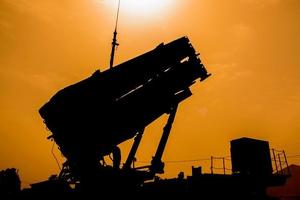 A US Patriot missile defence system is pictured during the Israeli-US military exercise "Juniper Cobra" at the Hatzor Airforce Base in Israel on March 8, 2018. (JACK GUEZ/AFP VIA GETTY IMAGES)
A US Patriot missile defence system is pictured during the Israeli-US military exercise "Juniper Cobra" at the Hatzor Airforce Base in Israel on March 8, 2018. (JACK GUEZ/AFP VIA GETTY IMAGES)
The US has removed two of its four Patriot antimissile batteries from Saudi Arabia and another two in the Mideast partly because tensions with Iran have eased from a peak earlier this year, according to a US official.
The two batteries in Saudi Arabia were helping protect the country’s oil fields and are likely to be replaced by Saudi Patriot batteries, according to a US official, who asked not to be identified discussing the change
The two batteries in Saudi Arabia were helping protect the country’s oil fields and are likely to be replaced by Saudi Patriot batteries, according to the official, who asked not to be identified discussing the change. More than 12 Patriot batteries and one THAAD battery, which can intercept ballistic missiles at higher altitudes, remain in the region, the official added.
The four Patriot batteries were scheduled to be withdrawn in March but their redeployment was delayed after two rocket attacks at Camp Taji in Iraq in mid-March, according to the official. The US blamed the strikes on Iranian-backed militias.
ALSO READ: Rouhani pledges 'crushing response' if US extends arms embargo
In addition to those changes, the rotation of US fighter squadrons means there has been a net loss of two 12-aircraft units in the Mideast, the official said. Asked about the changes, a Pentagon spokesman said U.S. capabilities in the Mideast remain “robust” and that it continues on a long-term effort to boost regional air defenses.
“The Department maintains robust in-theater capabilities, including air defense, to address any Iran-related contingencies as needed,” Navy Commander Sean Robertson said. “We also maintain the capability to augment these forces on short notice.”
Although President Donald Trump has long called for troop reductions in the Mideast, he began deploying additional forces to the region following last year’s downing of a US drone over the Persian Gulf and attacks on Saudi Aramco oil facilities, both of which the US and Saudi Arabia blamed on Iran.
That buildup included sending an additional Patriot missile battery, four radar systems and 200 personnel to Saudi Arabia in September as it sought to extend air defense coverage of the world’s largest oil supplier.
READ MORE: US to send 200 personnel, defense systems to Saudi Arabia
“Well, I don’t want to talk about it but we’re doing some things,” Trump said on Thursday when asked about the decision to remove the Patriot batteries. “We’re making a lot of moves, in the Middle East and elsewhere. We’re doing a lot of things all over the world militarily.”
Despite the modest drawdown, which was reported earlier by the Wall Street Journal, senior US defense officials maintain that Iran remains a threat.
“It’s fair to say that Iran continues its malign behavior throughout the region,” Secretary of Defense Mark Esper told reporters Tuesday at the Pentagon. “The Iranian government continues to export terrorism, continues to export this malign behavior from the Houthis, up into Iraq, across into Syria, you name it.”
Trump in April said on Twitter that he wanted the US Navy to destroy any Iranian gunboats that harass American ships at sea after 11 small vessels from Iran’s Islamic Revolutionary Guard Corps crossed the bows and sterns of American ships at close range.
READ MORE: Turkey seeks US patriot missiles to deter Russia in Syria
Saudi Arabia and neighboring Gulf states, including the United Arab Emirates, spent billions of dollars over the past decade boosting their missile defenses with the latest upgrades of the Raytheon Co-built Patriot and other antimissile systems.
The kingdom took delivery of Patriot-3 hit-to-kill missiles bought years ago to defend against cruise and ballistic missiles. It has used them to defend against missile attacks by the Houthi rebels it’s been fighting across its border in Yemen since 2015.


